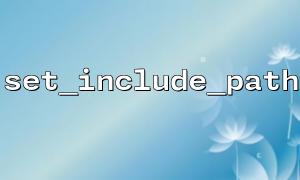set_include_path is a PHP function used to set the file inclusion path by modifying the include_path configuration. This allows PHP to look for files in specified directories. However, if used improperly in development, it can introduce a range of security risks. This article will discuss these risks and how to prevent them through proper strategies.
In PHP, the set_include_path function is used to set the search path for files. This function allows developers to add custom paths on top of the default file inclusion paths, which is especially useful in large projects or frameworks involving multiple modules referencing files.
<span><span><span class="hljs-title function_ invoke__">set_include_path</span></span><span>(</span><span><span class="hljs-string">'/var/www/myproject/includes'</span></span><span>);
</span></span>This line adds the /var/www/myproject/includes directory to the paths where PHP looks for files. With this path set, PHP can load files located in that directory, for example:
<span><span><span class="hljs-keyword">include</span></span><span> </span><span><span class="hljs-string">'myfile.php'</span></span><span>;
</span></span>While set_include_path offers great convenience during development, careless use can lead to serious security vulnerabilities, especially from external attackers.
One of the most common risks is path hijacking. When developers use unsafe paths or directly pass user input to set_include_path, attackers can exploit this to load malicious files. By adding malicious paths to include_path, attackers can control which files PHP loads, potentially causing unauthorized code execution, sensitive data leakage, or system damage.
If the code includes something like:
<span><span><span class="hljs-variable">$path</span></span><span> = </span><span><span class="hljs-variable">$_GET</span></span><span>[</span><span><span class="hljs-string">'path'</span></span><span>]; </span><span><span class="hljs-comment">// user input path</span></span><span>
</span><span><span class="hljs-title function_ invoke__">set_include_path</span></span><span>(</span><span><span class="hljs-variable">$path</span></span><span>);
</span></span>An attacker could visit a URL like example.com/script.php?path=/tmp/malicious_code to add a malicious file path to include_path and execute malicious code.
If PHP sets unsafe paths with set_include_path, attackers might manipulate path parameters to make PHP load local or system files, triggering local file inclusion vulnerabilities. This could lead to sensitive information exposure or remote code execution.
By modifying include_path, attackers might indirectly control which files are loaded. Without proper directory permission controls, unrelated sensitive files such as configuration or log files might be exposed to attackers, causing serious security issues.
One of the most important preventive measures is not to trust user input directly. All incoming path data should be strictly validated and sanitized to ensure path safety. Functions like basename can be used to strip potentially malicious path elements.
<span><span><span class="hljs-variable">$path</span></span><span> = </span><span><span class="hljs-title function_ invoke__">basename</span></span><span>(</span><span><span class="hljs-variable">$_GET</span></span><span>[</span><span><span class="hljs-string">'path'</span></span><span>]); </span><span><span class="hljs-comment">// get only the filename part</span></span><span>
</span></span>This approach ensures users cannot use directory traversal to access files from other directories.
Unless absolutely necessary, avoid frequent use of set_include_path. If files can be included using absolute or relative paths directly, there's no need to change include_path. Ensure that changes to this setting are strictly controlled and only done when essential.
During development, it is recommended to use fixed directory structures and define paths using constants instead of hardcoding paths in function calls. This helps better control file inclusion paths and reduces the risk of path hijacking.
<span><span><span class="hljs-title function_ invoke__">define</span></span><span>(</span><span><span class="hljs-string">'INCLUDE_PATH'</span></span><span>, </span><span><span class="hljs-string">'/var/www/myproject/includes'</span></span><span>);
</span><span><span class="hljs-title function_ invoke__">set_include_path</span></span><span>(INCLUDE_PATH);
</span></span>This method ensures path consistency and security, reducing the chance of errors.
To prevent loading external files via URLs, ensure that the allow_url_include setting in php.ini is set to Off. If enabled, attackers can load malicious scripts from external URLs.
Regularly audit and monitor file access logs on the server, especially access to sensitive or configuration files. Log analysis helps detect abnormal file access patterns, allowing timely prevention and remediation.
Although set_include_path is a powerful tool in PHP, improper use can introduce security vulnerabilities. To minimize risks, developers should follow best security practices by validating and sanitizing all user inputs, restricting file system access, and avoiding unnecessary changes to include_path. Additionally, strengthening logging and auditing can effectively prevent potential attacks.
By applying these measures, developers can enjoy the flexibility of dynamic file loading while ensuring the security of PHP applications.





